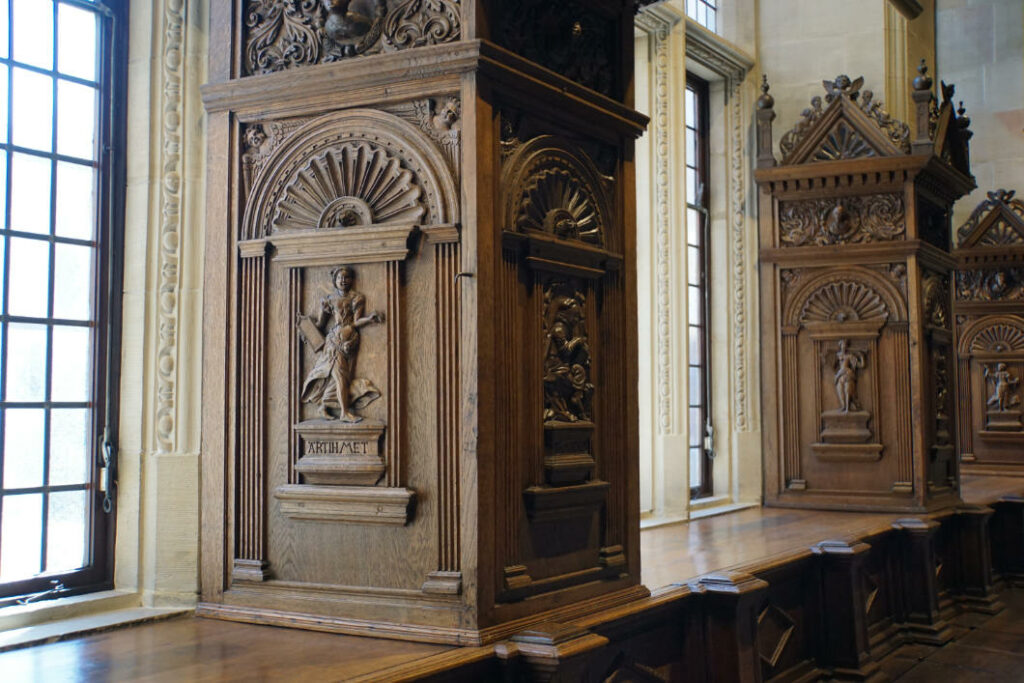An attraction for tourists from all over the world is the Peace Hall in Münster. During our time in Münster, a visit was definitely not to be missed, because history was made here.
Things to know about Münster’s Historic Town Hall
Münster received its city charter in 1170. The councillors now needed a place for meetings and court hearings. At first, a simple building near Prinzipalmarkt had to suffice. But not for long. When the parcelling of Prinzipalmarkt began, a plot of land was kept free for the construction of a new town hall. The plot was in direct line of sight of St. Paul’s Cathedral. In this way, the citizens wanted to emphasise their striving for freedom and self-government to the bishop.
Unfortunately, more precise information about the building is no longer available today. All documents in the town archives were destroyed during the Anabaptist rule in 1524/35. Only later sources provide information about the town’s development.

The town hall in Münster became really famous when the meetings of the Peace Congress of Westphalia were held here and in the town hall of Osnabrück between 1643 and 1648. These negotiations ended the 30-year war in Europe.
During the negotiations, the emperor declared the city neutral and released it from all obligations to the empire and the prince-bishopric. 150 envoys arrived and were greeted with a welcome drink from the “Golden Cock”. The Peace of Westphalia was not, however, negotiated or ratified in Münster’s town hall. However, the exchange of the signed treaties of the Peace of Münster (1648) took place here. However, the town hall served as a meeting place for the envoys outside the negotiations. Since the 18th century, the term “Friedenssaal” (Peace Hall) has been used for the Council Chamber.

Unfortunately, the town hall in Münster was hit by bombs during the Second World War and burnt out. Only the lower arches and the arcades were preserved.
The Peace Hall was first rebuilt for the 300th anniversary of the Peace of Westphalia. Fortunately, the panelling had been removed in the turmoil of the war and so the original could be used.
Finally, in 1950, the reconstruction of the Rathau began without the financial support of the city. The public’s support was enormous and the money flowed in abundantly. In 1958 it was done and the town hall shone in its new historical splendour.
In front of the town hall
We are standing in front of Münster’s Historic Town Hall and I am really impressed. For me, the façade outshines all the other buildings on the street.

The façade was built of Baumberg sandstone in the Gothic style. If you look at the building from the side, you can see that it is much higher than the actual gable of the house and is attached to the house with supports.
What I find amazing is the ornamentation, which is actually more reminiscent of a church building.
The façade is divided into three sections, the arcade floor, the main floor and the gable floor.
The arcade floor consists of four pointed arcades and 5 columns. Each of the columns has a different design.
On the main floor there are four large windows that have a similar shape to the arcades. Behind the windows is the large banqueting hall.
I like the gable floor best. It rises up like steps. It is structured by blind windows, niches, pillars and almost filigree connections between the pillars. In addition, you can recognise some coats of arms, for example the griffin with the city coat of arms.
Visit to the Peace Hall
Our goal is to visit the Council Chamber, or as the room is commonly called, the Peace Room.
From the entrance area, a door leads into the hall and I feel as if I am entering another world. The entrance is so bright and friendly and after here you enter a room that is furnished with dark wood panelling. Before I can even begin to grasp individual elements, a voice from a loudspeaker begins to tell me something about the history and everything worth seeing in the room. It’s very well done, but I’m too captivated by the individual elements and can hardly follow the explanation. It’s good that this is repeated, even if the next passage in French brings me to the edge of my fluency. The only thing that helps is to wait until I understand something again.

The council chamber is not particularly large, measuring only about 10 x 15 metres. The first thing that catches my eye is the beautiful wood panelling. These were created in the Renaissance style as early as 1577.
On the west wall, above the panelling and the benches, hang numerous pictures of the envoys of the negotiations for the Peace of Westphalia. The panelling itself is beautifully carved. There are four windows on the east wall. They are quite simple and only slightly tinted, so that sufficient light falls into the room. The wall surfaces are panelled in the same style as on the opposite side. Below the panelling are very uncomfortable-looking benches.

The eye-catcher for me in the council chamber, however, is the north wall of the room. Here, an imposing judge’s table stands in front of a huge wall of cupboards. The wall of cabinets contains compartments that are closed by doors. Each door is impressively decorated, some with biblical scenes, others with human vices. I can imagine how behind the mighty table the judge sat, gazing mercilessly at the accused. The look of the room alone must have inspired respect.

The south side is dominated by a chimney replica. The original was destroyed in the war. The Golden Cock, from which the envoys drank in greeting, stands in a glass case.
Anyone visiting the Peace Hall should plan some time. I think there are many small details to discover here that are simply beautiful.

Address:
Prinzipalmarkt 10
48143 Münster
Opening hours:
Tuesday – Friday: 10-17 h
Saturday, Sunday, public holidays: 10-16 h
Monday closed
ATTENTION! The hall remains closed during official events.
Admission fees:
Adults: 2€
Reduced: 1,50€
Discover the offers for Münster from Get Your Guide:
Disclosure: The visit to the Historic Town Hall took place as part of a press trip. The report is solely my own opinion.














Leave a Reply